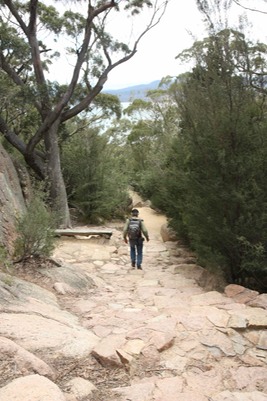But, back to Wineglass Bay, the view is quite magnificent. I wish Whitehaven had the height and the management.
 Heading down the hill it was time to turn our noses southward for the two hour haul back to Hobart, and time was getting on. Not getting on to the point where there was cause for concern, but enough to rule out a longer look at Coles Bay when we turned off the main road for a speculative glance. There are a number of other spots along the Freycinet Peninsula that would be worth a closer look but with Hobart beckoning and a desire to avoid absolute peak hour traffic it seemed our other Freycinet Experiences would be limited to the vineyard of the same name.
Heading down the hill it was time to turn our noses southward for the two hour haul back to Hobart, and time was getting on. Not getting on to the point where there was cause for concern, but enough to rule out a longer look at Coles Bay when we turned off the main road for a speculative glance. There are a number of other spots along the Freycinet Peninsula that would be worth a closer look but with Hobart beckoning and a desire to avoid absolute peak hour traffic it seemed our other Freycinet Experiences would be limited to the vineyard of the same name.
We turned in there, and Madam had her usual photographic ramble around the grounds while I sampled the Riesling, which was duly purchased, the Chardonnay, which was a definite contender, the Pinot Noir, which was impressive as well, and the Cabernet Merlot, which prompted an interesting discussion when Madam joined us in the tasting room.
A glance at the stats will reveal a preponderance of the bubbly varieties (Pinot Noir represents around 44% and Chardonnay 28% of the Tasmanian crush, though both are, of course used for used for table wine as well) with Sauvignon Blanc and Riesling taking the figures up around the 90% mark. There are, of course, other varieties. You’d tip Pinot Gris to start gaining prominence, and there are still a few hectares of Cabernet Sauvignon, Merlot and Gewürztraminer out there on the Tasmanian viticultural landscape, but we’re talking a cool climate area, and while you might expect things to change as global warming rears its ugly head, Tasmania isn’t a likely candidate for mass production of warmer climate varieties.
Based on that minor factoid, I’d tended to ignore anything in the Shiraz or Cabernet line, though one notes a Tasmanian shiraz, Glaetzer Dixon, Mon Père 2010 took out the coveted national Jimmy Watson Trophy a while back. There’s always an exception that proves the rule.
My earlier visit to the Apple Isle six years earlier had produced an impression of vineyards removing Cabernet Sauvignon vines since the late-ripening variety was difficult to ripen in these parts, yet here I was in Freycinet, sampling a Cab Merlot that was definitely one to buy. A remark about these matters to the older bloke in the Cellar Door produced a suggestion that I raise the matter with a passing wine maker, which I did.
The question of whether it was possible to ripen Cabernet grapes might seem irrelevant on the basis that there was a Cab Merlot in front of me, but the answer ran along the lines of you can, but it’s difficult because you need the right site and the right sites are not easy to find. Further research seems to suggest relatively warmer areas like the Freycinet Peninsula and the Coal River Valley offer better prospects for the Bordeaux varieties than cooler areas like the Tamar Valley and Piper’s Brook, which figures since that was where I was told things like we used to have Cabernet, but we had to pull it out because the grapes didn’t ripen.
So Pinot, Chardonnay and Riesling all over, Cabernet on selected sites in the south and east where you’re possibly getting a milder maritime influence might be a workable hypothesis.